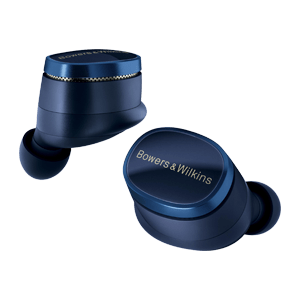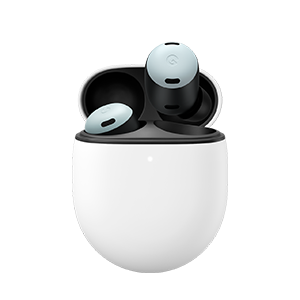Why trust Reddit? With so many new wireless earbud models constantly hitting the market, it’s tough to know which ones truly deliver on sound quality, comfort, and battery life. Reddit offers real user experiences and honest discussions that cut through the marketing noise, helping you make a confident choice.
That’s why we looked beyond flashy ads and tech specs. Instead we dove into real user experiences on Reddit.
In this guide, you’ll find top-rated wireless earbuds recommended by Reddit users, whether you’re after powerful noise cancellation, a secure fit for workouts, or just great value for the price.
Best Wireless Earbuds Reddit Picked in 2025
The Technics AZ100 earbuds are shaping up to be the premium earbuds of 2025, improving on the already excellent AZ80s in six key areas.
First, their Magnetic Fluid Drivers deliver cleaner, more precise sound with improved high-resolution audio. Add Dolby Atmos with head tracking, and these buds create an immersive, spatial audio experience unmatched in this category. Adaptive Noise Cancelling is another standout now smarter and more seamless, making noisy environments a breeze.
For phone calls, the Voice Focus AI mode is a game-changer, filtering noise on both ends so both you and your caller hear crystal clear. Even better, these features are all easily accessible through the Technics Audio Connect app.
The AZ100 also introduces LE audio mode, enabling LC3 codec streaming and future Auracast compatibility. Plus, their smaller, more ergonomic design fits snuglyeven for smaller ears without sacrificing features like three-way multi-point connectivity or high-res certification.
In noisy environments like crowded trains, the mic pickup is stellar. The AZ100 significantly outperforms the AZ80, amplifying voices while filtering background noise efficiently. Active noise canceling is another highlight, offering subtle but effective masking, while the improved transparency mode ensures clear ambient sound pass-through for conversations.
Sound quality? Phenomenal. Bass is textured and deep, soundstaging feels expansive, and separation between tracks is crisp. Vocals are slightly less sharp than the AZ80, but overall, these are a step closer to flagship models like the Bowers & Wilkins PI8.
In short, the AZ100 combines outstanding audio performance, adaptive ANC, top-notch call quality, and sleek design into one impressive package. Whether you’re upgrading from the AZ80 or exploring high-end earbuds for the first time, these are worth every penny.
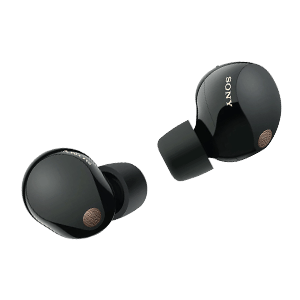
Best Customizable Earbuds
2
SONY WF-1000XM5
The Sony WF-1000XM5 has received strong praise from users for its standout noise cancellation, sound quality, and improved comfort. Many report that its ANC outperforms both the Technics AZ1000 and Bowers & Wilkins Pi8, especially in busy environments like public transport or windy outdoor settings.
In terms of sound, users note a slightly bass-forward profile that suits workouts and casual listening. While the Pi8 is often preferred for its natural vocal presentation, the WF-1000XM5 offers a more spacious soundstage and greater balance overall. The Technics AZ1000 delivers clean mids but lacks the XM5’s punch and adaptability, especially since Sony’s app allows full EQ customization.
Comfort has seen a big improvement. With a 25% smaller and 20% lighter design than its predecessor, the XM5 fits more comfortably for extended wear, something users often highlight when comparing it to the bulkier Pi8. Controls are responsive, and Bluetooth multipoint support makes switching between devices hassle-free.
Battery life also earns positive feedback. Most users report getting around 9 hours on a single charge, with the case providing multiple recharges for a total of up to 24 hours. Sony’s companion app is often mentioned as a key advantage, offering personalized control over both sound and ambient noise levels.
The WF-1000XM5 is seen as a premium but worthwhile investment. While iPhone users might lean toward the AirPods Pro for ecosystem integration, those on Android and anyone prioritizing top-tier ANC and audio flexibility find the XM5 a clear winner over the AZ1000 and Pi8.
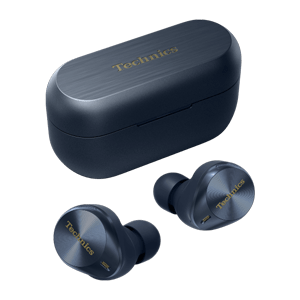
Best Value Earbuds
3
Technics AZ80
The AZ80’s clean, minimalist styling is what catches the eye at first. Its matte case with a brushed-metal lid feels more refined than the AZ60 and slightly sleeker than the earlier AZ100.
The earbuds’ vinyl-record-inspired touch surfaces nod to Technics’ heritage, and despite their larger size, their vertical profile offers a secure, comfortable fit, even during light activity outperforming the bulkier AZ100 in this regard.
Where the AZ80 truly excels is in sound. Technics delivers an open, spacious soundstage ideal for layered tracks. Treble is detailed with a pleasant sparkle, and bass especially via the “Super Bass” preset packs a punch without muddying the mids. The reviewer gravitated toward the dynamic preset, which balances bass and treble beautifully.
Vocals are clear and natural, and instrument separation is superb. In this category, the AZ80 rivals the Sony WF-1000XM5 and even outshines the AZ100’s warmer signature, though audiophiles seeking absolute treble precision might still prefer a finely tuned XM5.
ANC on the AZ80 is effective for commutes and office use, yet it falls just short of the Sony XM5’s deeper noise suppression and AirPods Pro 2’s transparency. Its ambient mode, however, offers natural, customizable passthrough that feels more organic than the AZ100’s.
Connectivity is a standout: simultaneous pairing with up to three devices one more than the XM5, though LDAC support drops when all three are active. Switching devices is smooth, provided apps are paused beforehand.
Battery life reaches about seven hours per charge (24 with the case) and offers 70 minutes playback after 15 minutes of charging. Wireless charging makes it more convenient than the AZ100. Call quality is solid, thanks to Technics’ “Just My Voice” feature and background noise reduction even from the caller’s end though it doesn’t quite top the XM5’s clarity.
For those seeking audiophile-grade sound with daily-driver versatility and a nod to Technics history the AZ80 strikes an excellent balance.
The AirPods Pro 2nd Generation continues Apple’s legacy of clean design and ecosystem integration.
The compact stem design offers a secure fit, though for active users or those wearing masks, the protruding stem can be inconvenient, something stemless models like the AZ100 or XM5 handle better. The new case now includes a built-in speaker for Find My alerts and low-battery sounds, which can be muted in iOS settings.
While its IPX4 rating handles splashes, it’s not as rugged as the Bose QC Ultra’s IPX rating.
Sound quality is strong overall. There’s a subtle sub-bass lift that adds body without overpowering mids or highs. The tonal balance is similar to the first-gen, though slightly more refined. Clarity is good, but detail in treble isn’t quite at the level of the Technics AZ100 or XM5. A proper in-ear seal is critical to get the best performance, especially with ANC.
Active noise cancellation is where the AirPods Pro 2 really stands out. It’s a clear improvement over its predecessor and rivals the XM5 and Bose QC Ultra in daily environments. While the Bose still holds the edge in raw noise blocking, Apple’s adaptive transparency mode feels more natural and seamless.
Battery life is average is about 5.5 hours on a single charge and up to 24 hours with the case. It lags behind the XM5 and Technics AZ100, both of which offer longer playback. Still, Apple compensates with versatile charging options including MagSafe, Lightning, Apple Watch chargers, and Qi wireless pads.
For iOS users, the AirPods Pro 2 remains a top pick, blending excellent ANC, tight Apple integration, and decent audio performance. While not the absolute best in every category, they’re hard to beat for Apple users prioritizing ease of use and reliable sound.
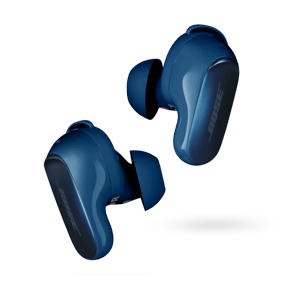
Best AirPods Alternative
5
Bose QC Ultra
We found the QuietComfort Ultra’s noise-cancellation to be truly top-tier, rivaling the Sony WF-1000XM5 and easily besting the Technics AZ100’s milder suppression.
In busy cafés and on the morning commute, the QC Ultra blocks chatter and rumble with ease, on par with the Bose QC Earbuds Gen II, though not a dramatic leap forward. Compared to the AirPods Pro 2, Bose pulls ahead in raw ANC power.
A standout is spatial audio with head-tracking, which neither the Gen II. While some may skip 3D sound, anyone craving immersion will appreciate Bose’s implementation is something the XM5 and AZ100 lack entirely.
On sound quality, the QC Ultra delivers the classic Bose signature: clear mids and highs and a balanced presentation that excels at jazz or podcasts. Yet bass heads may miss the extra low-end punch found on the XM5 or in the warmer AZ100 tuning. Unlike Sony, Bose offers no EQ presets, so users craving customization will find the XM5 or even AirPods Pro (via iOS EQ) more flexible.
Snapdragon Sound support gives the QC Ultra an edge on compatible Androids, boosting fidelity beyond what Bluetooth LE delivers. iPhone users won’t see a benefit here, putting them back on even footing with AirPods Pro.
Comfort is improved over earlier Bose buds: the QC Ultra nestles securely without feeling bulky. But the charging case is noticeably larger than those of the AirPods Pro, XM5, or AZ100, making pocket storage less seamless. Volume adjustments still require a phone and no swipe controls as on the XM5.
Transparency mode works, but it can sound slightly artificial compared with Apple’s shockingly natural passthrough or Sony’s adaptive ambient feature.
With about six hours per charge and additional power in the case, battery life is respectable but trails the XM5’s seven-hour runtime. Overall, the QuietComfort Ultra offers elite ANC, spatial audio, and Android-friendly codecs, but for those prioritizing bass impact, EQ flexibility, or compact carry, the XM5, AZ100, or AirPods Pro may be stronger picks.
Pi8 is one of the earbuds that offer a design both elegant and purposeful. The matte-finish stems house touch controls that now let you toggle transparency mode without ever opening an app it’s the kind of convenience missing on the Technics AZ100 and Sony XM5.
Bowers & Wilkins also fixed the Pi7S2’s awkward ear-detection quirks, so both buds stay reliably connected even on wider head shapes.
In daily listening, the Pi8 stands out for sheer volume. While they usually top out around 50–60% on most earbuds, 30–40% is more than loud enough here certainly louder than either the AZ100 or XM5. The charging case doubles as a wired DAC/amp bridge via USB-C or aux, and those wired sessions bring a noticeable lift in volume and subtle tonal shifts that audiophiles will love.
Sound customization is handled through a graphic EQ in the B&W app which is an upgrade over the Pi7S2, but without presets it can feel daunting next to the more user-friendly EQ profiles on Technics or Sony. Still, the Pi8’s signature is energetic: vibrant mids and highs, smooth separation, and a bass response that’s tighter and less boomy than the Pi7S2’s.
Noise cancellation is solid but not class-leading. It tames city noise competently, though it doesn’t quite match the Sony XM5’s deeper hiss-blocking or the AZ100’s warm yet powerful suppression. Transparency mode is clear and natural and on par with Sony, and arguably more nuanced than Technics.
Call quality is decent in quiet spots but can feel gated in crowds, cutting off softer speech. Overall, for anyone who prioritizes sound above all, the Pi8 delivers a thrilling, detailed performance, even if they sacrifice a bit of ANC muscle and app polish compared to the XM5 or AZ100.
The Pixel Buds Pro 2 made a strong impression right out of the box. Lighter and smaller than the first-gen model, they now feel much more comfortable for daily use.
The micro-fin design keeps them secure, whether walking through a busy city or relaxing at home. While not as snug as the Bowers & Wilkins PI8 or the AirPods Pro 2, the fit is still solid, though some might fumble a bit distinguishing the left from right earbuds quickly.
Battery life is one of the strongest features. With ANC on, they lasted around 8 hours, stretching up to 12 with ANC off and the case pushes that even further. Compared to the AirPods Pro 2, these easily outlast them. If battery life is a deal-breaker, the Pixel Buds Pro 2 come out ahead.
Sound-wise, they’re clean and customizable. The new EQ presets in the app make adjusting the profile easy, and while the audio doesn’t quite reach the detailed richness of the PI8 or the refined balance of the AirPods Pro, they hold up well for casual listening.
Mic quality is another highlight. In quiet environments, voice pickup is crisp and clear, easily rivaling (but matching) AirPods Pro and beating out the Pi8 in noisy conditions. Background noise is handled well, with minimal interference even in traffic or bustling cafes, the caller on the other end could hear every word clearly.
The case also got smarter with a built-in speaker for Find My Device alerts and audible battery warnings. Handy upgrades that Apple and B&W don’t quite match in day-to-day convenience.
That said, ANC is a weak spot noticeably behind both the Pi8 and AirPods Pro 2. Multipoint also needs polishing; switching between devices isn’t seamless.
Overall, for those deep in Google’s ecosystem or looking for great mic and battery performance, the Pixel Buds Pro 2 are easy to recommend.
Earbuds Sound Comparison
Battery Life of ANC Earbuds (Hours)
Things to consider before buying earbuds
Comfort & Fit
Additional Tips:
Intended Use & Environment
Battery Life
Additional Tip:
Noise Control Features
Sound Quality
Controls & Smart Features
Additional Features to Look For:
Connectivity & Compatibility
Call Quality
🔬 How We Test Wireless Earbuds
At Intoptrend, we follow a standardized, real-world testing process to evaluate each pair of wireless earbuds we review. Our categories include:
- Sound Quality: We assess bass, midrange, and treble clarity across multiple genres for balance and immersion.
- Microphone Performance: Tested in quiet rooms and noisy outdoor environments to ensure clear communication.
- Battery Life: Playback duration, case recharge cycles, and charging speed are measured under daily use conditions.
- Connectivity: We evaluate Bluetooth stability, range, codec support, and pairing speed.
- Comfort & Fit: Earbuds are worn for long periods and during movement to assess comfort and security.
- Controls & Features: We test responsiveness of touch or physical controls and explore app-based customization.
- ANC & Transparency: Active noise cancellation and ambient sound modes are evaluated in public and indoor settings.
- Build Quality: We review durability, IP ratings, and overall construction quality.
- Value: Features and performance are weighed against the product’s price and category competition.
This approach ensures every review is fair, consistent, and informative—so you can make confident purchasing decisions.
FAQ
What are the best Bluetooth earbuds for 2025?
Best Overall: Technics EAH-AZ100
With industry-leading noise cancellation, Dolby Atmos with head tracking, and exceptional comfort, the Technics EAH-AZ100 is the top pick for 2025. Excellent battery life and pristine sound quality seal its place at number one.
Runner-Up: Sony WF-1000XM5 – Great balance of ANC, sound, and usability.
Anticipated: Sony WF-1000XM6 – Expected to launch later in 2025 with enhanced features.
What is the best earbuds for 2025 according to Reddit?
Reddit users have widely praised the Technics EAH-AZ100 for its balanced sound, premium feel, and cutting-edge features. In multiple threads, users call it the “best overall TWS in 2025.” Their consensus highlights strong noise cancellation and premium audio experience as deciding factors.
What are the highest quality wireless earbuds?
When evaluating sound quality, build, and overall performance, the top-tier choices for 2025 are:
- Technics EAH-AZ100 – Studio-grade sound and smart ANC.
- Sony WF-1000XM5 – Balanced sound and smart features.
- Sony WF-1000XM6 (upcoming) – Expected to push the boundaries in fidelity and comfort.
Why are Gen Z plugging their headphones in?
- Fashion statement: Wired headphones are now a retro aesthetic trend.
- Affordability: Wired options are cheaper and accessible.
- Practicality: No charging needed, durable cables, good audio quality.
- Nostalgia: Gen Z enjoys vintage tech as part of a cultural revival.
For a quick glance at the pros and cons of the all the wireless earbuds you can browse our pros and cons list on Reddit at r/soundnation


